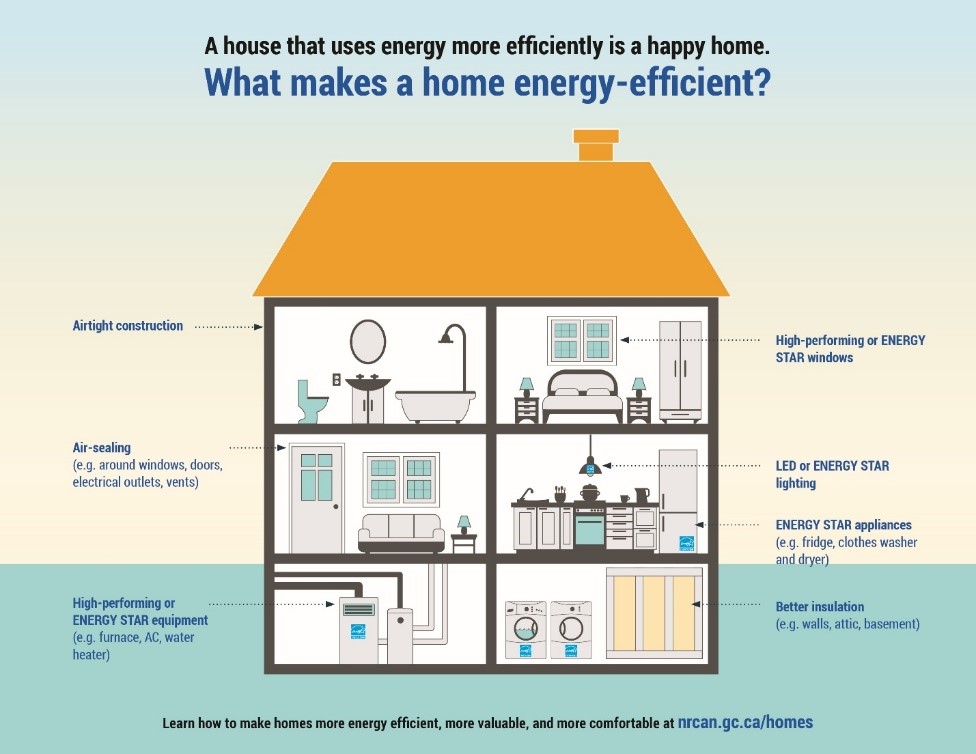Every part of a Net Zero Home works together in harmony to create the ultimate energy efficient living space. Every aspect of the home, including the building envelope, mechanical systems, and renewable energy systems, works together as a system to ensure peak performance. Through advanced “building science” techniques, technologies, and products, builders can significantly reduce a home’s energy consumption. Here are the three main components of a Net Zero Home.
Superior Building Envelope
Most Canadian homes use roughly half of their energy consumption on space heating. Net Zero Homes, on the other hand, use only about a quarter of the energy of conventional homes on space heating. Why? Well, Net Zero Homes have a superior building envelope. The building envelope is considered the “shell” of the home because it separates the indoor environment from the outdoor environment. It includes the home’s overall airtightness, the insulation of the exterior walls, floors, ceilings, and foundation, as well as high-performance windows and doors. A Net Zero Home’s superior building envelope is extremely airtight and uses a significant amount of insulation to reduce heat loss in the winter and heat gain in the summer. This keeps heated or cooled air from leaking through cracks and holes to the outside, which in turn means that less energy is needed to heat and cool the home. Further, the improved building envelope of a Net Zero Home makes it more comfortable. It eliminates drafts, helps maintain even temperatures throughout the home, and blocks out exterior noise, such as traffic, barking dogs, and lawnmowers.
 Photo: Natural Resources Canada
Photo: Natural Resources Canada
Smaller HVAC/Mechanical Systems
Since the “shell” of a Net Zero Home is so much better than that of a conventional home, the mechanical systems, including the space heating/cooling, water heating, and ventilation, are typically smaller (properly sized for the home), and more energy efficient models are used. A Net Zero Home’s heating and cooling is typically done by an electric air source heat pump, with a backup natural gas or electric furnace. The home’s hot water is usually heated with a condensing water tank or an instantaneous tankless water heater. To ensure exceptional indoor air quality, a mechanical ventilation system brings filtered fresh air into the home and takes stale air out. As such, the filtered fresh-air system reduces allergens and asthma triggers like dust, pollen, and outdoor air pollution for healthier living. And finally, Net Zero Homes come equipped with an energy monitoring system that allows the occupant to see how much energy is being used (some are capable of helping you find where phantom energy usage is coming from) and if the home has a renewable energy system installed, it will also show how much energy is being generated.
 HVAC Smart Duct System in a Net Zero Home by Doug Tarry Homes
HVAC Smart Duct System in a Net Zero Home by Doug Tarry Homes
Renewable Energy Systems and Storage
Net Zero Homes produces as much clean energy as they consume using on-site renewable energy systems. The most commonly used is a roof-mounted solar photovoltaic (PV) system – also known as solar panels. Solar panels are reliable, require little ongoing maintenance, and it’s easy to estimate the amount of electricity they’ll produce annually.
 Solar panels on Net Zero townhomes by Sifton Properties
Solar panels on Net Zero townhomes by Sifton Properties
If a battery system has not been installed, electricity goes directly to the utility grid, in a power credit process agreement with the utility called “net metering.” A Net Zero Home can use net metering to offset its energy consumption, breaking even on an annual basis – hence the term “net zero”. Most Net Zero Homes in Canada produce a surplus of energy in the summer and need more energy than they can produce in the winter, using the solar “credits” produced in the summer to offset the energy needed in the winter. Alternatively, some Net Zero Homes use batteries to store the electricity generated on-site to power the home during peak hours, blackouts, and sometimes even to charge an electric vehicle!
CHBA Qualified Net Zero Builders and Renovators understand how to incorporate these building techniques into a well-built, energy efficient home that is the ultimate in comfort and efficiency.
To learn more about Net Zero Homes or to find a Qualified Net Zero Builder/Renovator in your area, visit netzerohome.com. Plus, follow CHBA Net Zero on Instagram to see a variety of Net Zero/Net Zero Ready Homes and all they have to offer!
